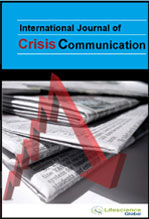IJCJ
|
|
Abstract: The main aim of the study was to analyze the sentiments about Muslim comedians in America. Soon after the attacks of September 11, 2001 in the United States, many Muslim American stand-up comedians had to suffer Islamophobia; the stereotype perceptions and hatred remarks about them because of their Muslim Identity. Therefore this study applied the qualitative content analysis technique to investigate the role of Muslim comedians and the sentiments of the viewers about their stand-up comedy videos. The findings showed that Muslim comedians are engaged in dialogue to help the Muslim community deal with the impact of the September 11 attacks and to try reassure the public about Arab and Muslim Americans as being unpatriotic and hostile to the United States. Muslim American stand-up comedy is a unique response to negative social discrimination after 9/11, and social critic’s comedians debate the stereotype and reality of Muslim American life. Analysis of functionalist theory from humor sociology to discern expected social messages of joke intended for entertaining and education. It shows how the American Muslim comedy affects American Muslims. Keywords: Muslim, Comedians, Stand-up comedy, Islomophobia.. |
|
|
Abstract: This study sought to answer the research question: How did media address climate change in reporting on Hurricanes Harvey and Irma? A content analysis was performed on the coverage of Hurricanes Harvey and Irma over a six-week timeframe by two national newspapers, The New York Times and the Los Angeles Times, and two local newspapers, the Houston Chronicle for Hurricane Harvey and the Tampa Bay Times for Hurricane Irma. A keyword analysis yielded 630 news articles (N=630), of which only 23 (3.65%) mentioned “climate change,” “global warming,” or both. Language that addressed these terms was coded on a Likert Scale (0-5, negative to positive), yielding a median score of 3.44, “slightly positive.” An extensive literature review and discussion of the findings and implications for future research are included. Keywords: Hurricane Harvey, Hurricane Irma, climate change, global warming, newspaper content analysis. Download Full Article |
|
|
Download Full Article |
|
|
Abstract: Truth is the generally accepted standard of news media organizations and of social media networks. Most of the codes of ethics including Al Jazeera’s specify the reporters’ duty to tell the truth. In the traditional view, objective reporting is not merely the standard of competent professionalism, but considered a moral imperative. With the dominant scheme increasingly controversial, theoretical work in international media ethics seeks to transform it intellectually. Truth needs to be released from its parochial moorings in the West and given a global understanding. A new concept of truth as authentic disclosure accomplishes this, and that definition means to get at the core issue, to see the essence of things. The question in researching Al Jazeera is whether it practices what might be called “interpretive sufficiency.” This is a robust view of news as knowledge production, in contrast with news as simply informational. Using Al Jazeera as a case study, the new definition of truth-as-disclosure is applied to crisis journalism. Keywords: International News, Truth, Media Ethics, Interpretation, Propaganda. Download Full Article |
|
|
Abstract:Our planet is facing environmental challenges of a magnitude unseen in the 200,000+ years of human ascendancy on its surface. It is widely predicted and generally agreed that during this century, anthropogenic climate change will create conditions that necessitate the largest human migrations in history. Some of these changes are occurring gradually, such as rising sea levels and dwindling supplies of fresh water, allowing time for warning and preparation. Others, such as hurricanes and floods, occur with little notice. These climate-driven events have their greatest effect on disadvantaged populations. Drought, famine and war are now causing the largest displacement and migration of people since World War II. The continuing social and political effects of these migrations are contributing to an unstable geopolitical environment that threatens the cooperative liberal democratic alliances that have helped prevent another global war. The rise of populism in the U.S. and Europe adds to the instability. Journalists are trying to meet these 21st-century environmental and political challenges with 20th-century norms and practices. The Society of Professional Journalists’ Code of Ethics calls on journalists to “seek truth and report it,” and objectivity in the conduct of that search is highly prized. Journalists have widely adopted the “conflict frame” as a vehicle to satisfy the demand for objectivity, presenting voices from “both sides” of an issue, a device that reduces the complexity of an issue to only two views while ignoring other valuable perspectives. The conflict frame creates a “false equivalency,” in which fringe voices are presented as the equals of experts. Climate-change deniers debate climate scientists, creationists argue with geneticists, and uber-nationalists confront diplomats. Uber- and alt- views are normalized, facts are elusive, and the line between opinion and fact and opinion is erased. Using a mixed-methods approach of framing theory and media effects, this study examines the use of the conflict frame in covering environmental and political stories in the 12 months of 2016 by journalists in three major publications: The Washington Post, The New York Times, and The Wall Street Journal. It models the architecture of the informational structure created by the conflict frame, and analyzes its effects on the communication process. Keywords: False equivalency, conflict frame, crisis communication, framing, media effects, journalism norms, journalism models, journalism ethics, environmental communication. |



